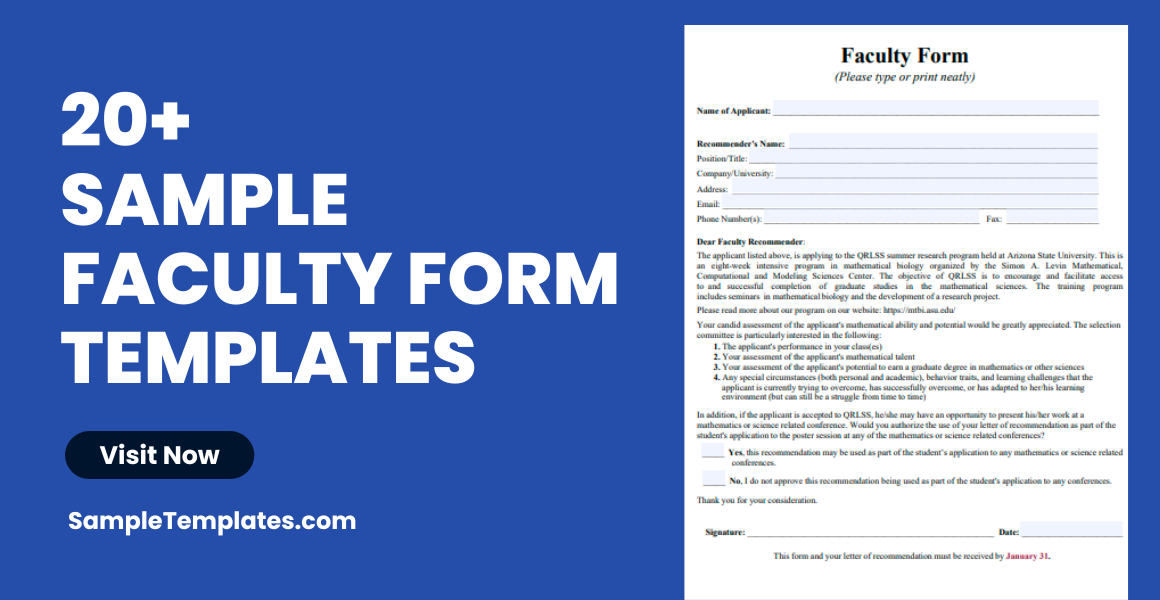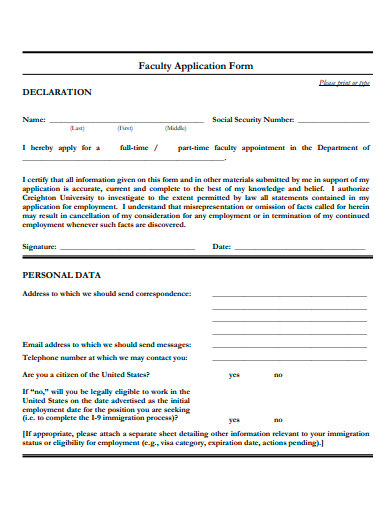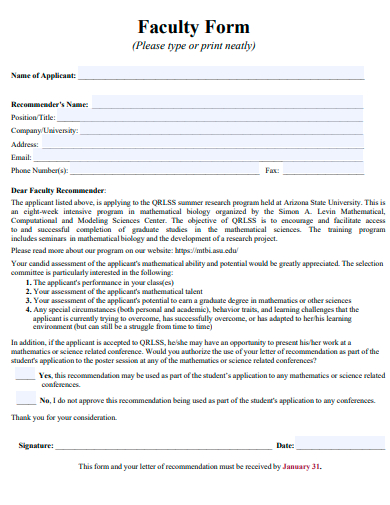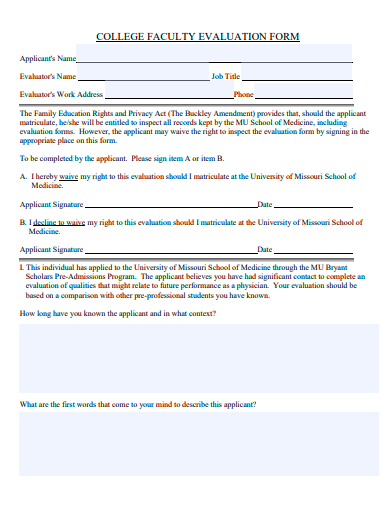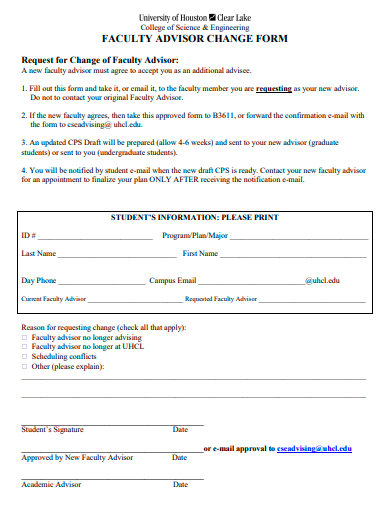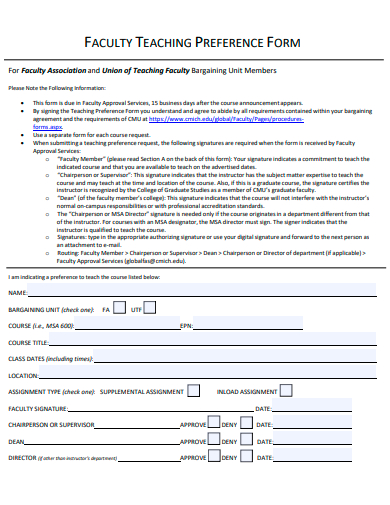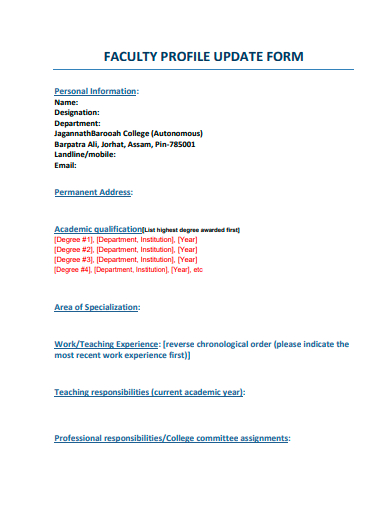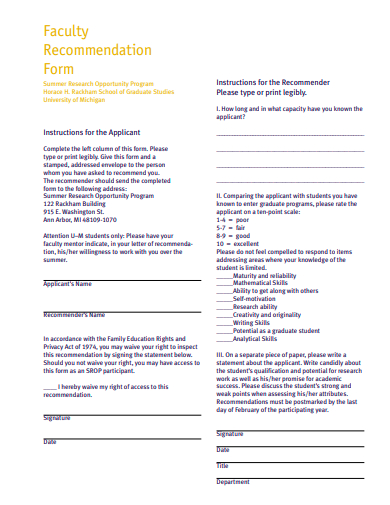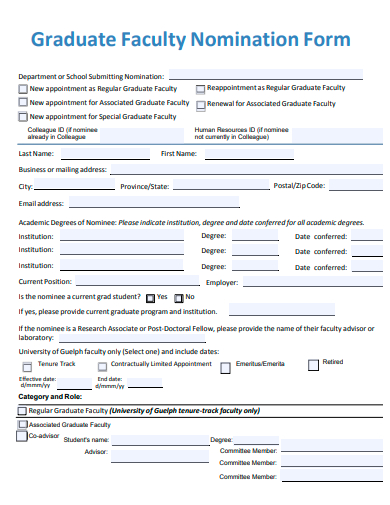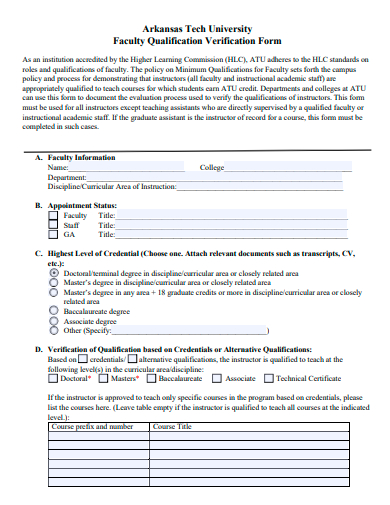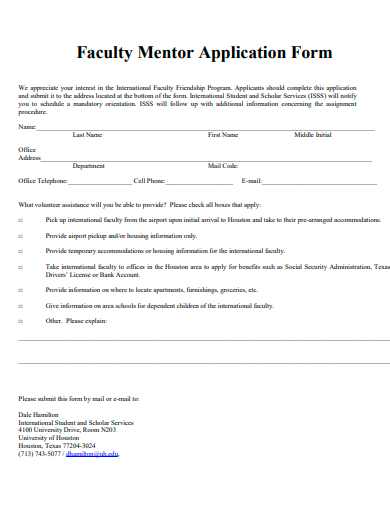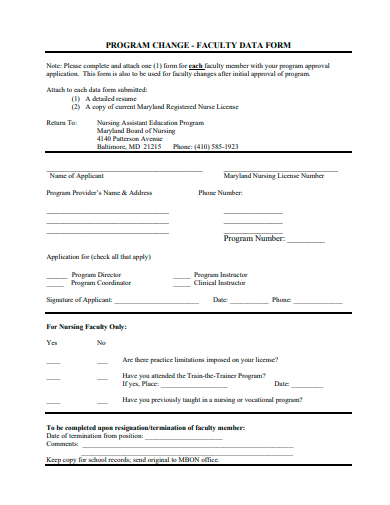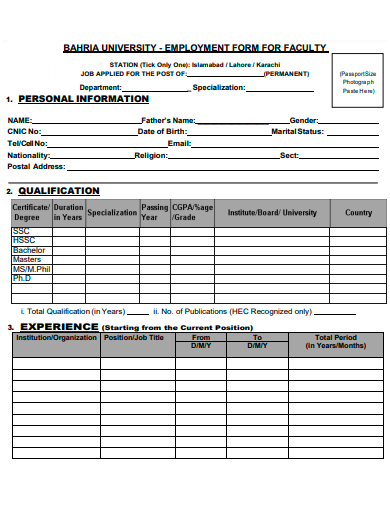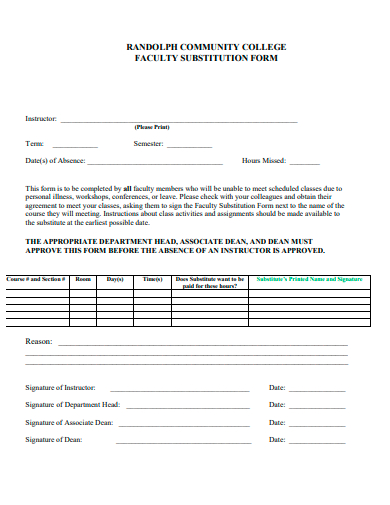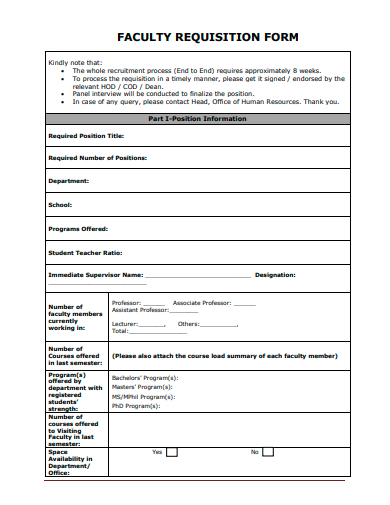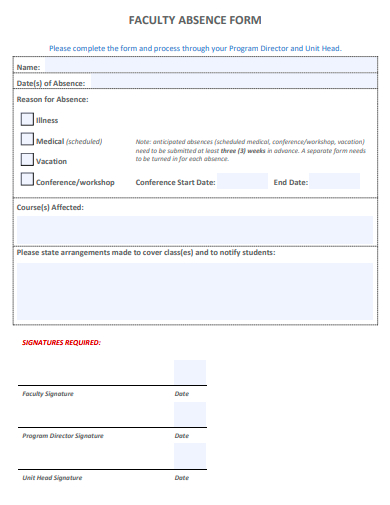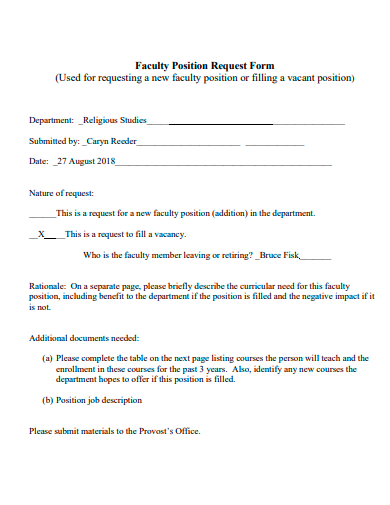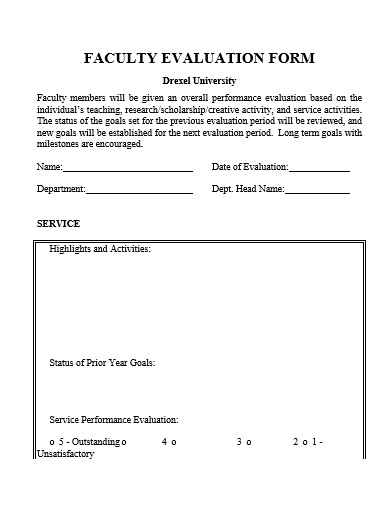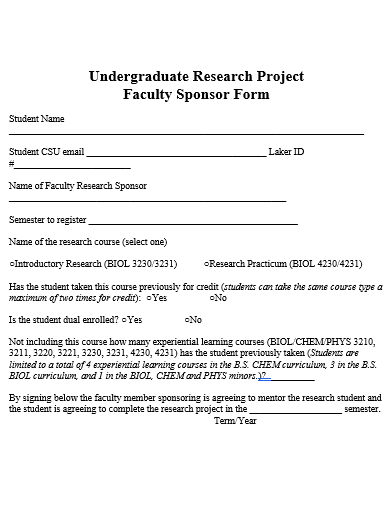Welcome to our comprehensive Sample Education Faculty Form template! If you’re aspiring to join the world of academia or seeking to streamline your education faculty recruitment process, you’re in the right place. Our meticulously crafted template is designed to simplify and expedite the Education Form application and selection process. From gathering essential candidate information to evaluating qualifications, this template covers it all. It’s the ultimate tool to ensure a seamless and efficient faculty recruitment process within the education sector. Explore our user-friendly template and revolutionize your institution’s education faculty hiring today.
20+ Faculty Form Samples
1. Faculty Application Form Template
2. Sample Faculty Form Template
3. College Faculty Evaluation Form Template
4. Sample Faculty Advisor Change Form Template
5. Faculty Teaching Preference Form Template
6. Faculty Feedback Form Template
7. Faculty Arrangement Form Template
What Is a Faculty Form?
A faculty form, often referred to as an academic faculty application form, is a crucial document used in the field of education and academia. This form serves as a formal and structured means for individuals to apply for faculty positions at educational institutions, such as universities, colleges, and schools. It plays a pivotal role in the faculty recruitment process, allowing educational institutions to efficiently gather essential information from prospective faculty members.
Here are some key components and aspects of a faculty form:
Personal Information: The sample form typically begins by collecting basic personal information from the applicant, including their name, contact details, address, and social security or identification number. This section establishes the applicant’s identity and contact details for further communication.
Educational Background: Faculty forms extensively detail the applicant’s educational history. This includes information about their degrees, majors, institutions attended, graduation dates, and any academic honors or awards received. Providing this data allows the institution to assess the applicant’s qualifications and suitability for the faculty role.
Professional Experience: Applicants are required to sample list their professional experience, which may include prior teaching positions, research roles, or any relevant work experience in the academic field. This section helps the institution gauge the candidate’s practical knowledge and expertise.
Teaching Philosophy: Some faculty forms include a section for applicants to articulate their teaching philosophy. This allows candidates to express their beliefs and approaches to teaching, which can be vital in assessing their alignment with the institution’s educational values.
Research and Publications: For academic positions, applicants are often asked to provide information about their research activities, publications, and scholarly contributions. This section helps institutions evaluate the candidate’s research potential and their ability to contribute to the institution’s academic reputation.
References: Faculty forms typically request references from the applicant, which may include contact information for academic advisors, mentors, or former colleagues who can vouch for their qualifications and character.
Cover Letter and Resume: Some faculty forms may require applicants to attach a cover letter and resume. These documents offer candidates an opportunity to provide additional context to their application and highlight specific achievements or qualifications.
Statement of Interest: In some cases, applicants are asked to submit a statement of interest, outlining their reasons for applying to the institution and explaining how they would contribute to the academic community.
Signature and Consent: The form is usually concluded with a section for the applicant’s signature, indicating their consent to the provided information and acknowledgment of the institution’s application terms and conditions.
A faculty form is a comprehensive document designed to collect essential information about individuals seeking academic faculty positions. It serves as a structured and standardized way for educational institutions to evaluate the qualifications, experience, and suitability of candidates. The information gathered through these forms plays a pivotal role in the faculty recruitment process, enabling institutions to make informed decisions about hiring faculty members who will contribute to their educational mission and academic excellence.
8. Sample Faculty Profile Update Form Template
9. Faculty Recommendation Form Template
10. Graduate Faculty Nomination Form Template
11. Faculty Qualification Verification Form Template
12. Sample Faculty Mentor Application Form Template
13. Faculty Data Form Template
How to create a Faculty Form?
Creating a faculty form is a comprehensive process that involves careful sample planning and design. This form is essential for streamlining the faculty recruitment process and gathering crucial information from potential candidates. Here’s a step-by-step guide on how to create a faculty form:
Determine the Purpose and Scope:
Begin by clearly defining the purpose statement of the faculty form. Identify what information you need from applicants and how it will be used during the recruitment process. Consider the specific faculty positions and departments it will cater to.
Identify Necessary Fields:
Create a list of all the information required from applicants. This may encompass personal details, educational background, professional experience, references, and other pertinent data. Differentiate between mandatory and optional fields.
Design the Form Layout:
Craft a user-friendly and visually appealing form layout. Employ clear headings and subheadings to organize different sections of the form. Consider using online form-building tools for ease of use.
Provide Clear Instructions:
Offer concise and easy-to-follow instructions for applicants. Clarify any specific requirements for attachments, such as resumes or cover letters. Use tooltips or help text to assist applicants if needed.
Ensure Legal and Privacy Compliance:
Ensure that the form complies with privacy and data protection laws. Include a privacy statement explaining how applicant data will be handled and obtain consent where necessary.
Create an Online Version:
If feasible, make the form available online through your institution’s website or application portal. Test its functionality on various devices and browsers to ensure a smooth user experience.
Review and Test:
Prior to making the form live, thoroughly review it for errors or inconsistencies. Test all form fields, buttons, and submission processes. Seek feedback from colleagues or volunteers who can simulate the applicant experience.
Pilot Run and Collect Feedback:
Conduct a pilot run with a small group of applicants. Gather feedback from both applicants and your recruitment team to identify and address any usability issues.
Implement and Promote:
Once finalized, launch the faculty form and promote it through your institution’s website, job postings, and relevant channels.
Establish Data Management:
Set up a secure system for managing and storing applicant data collected through the form, such as a database or applicant tracking system (ATS).
Monitor and Update:
Continuously review and update the form to adapt to changing recruitment needs or legal requirements. Regularly assess its performance and gather applicant sample feedback to enhance the application process.
Creating an effective faculty form is a pivotal step in ensuring a streamlined and efficient faculty recruitment process. By following these steps and giving attention to detail, you can design a form that collects the necessary information to evaluate and select the most suitable candidates for faculty positions at your educational institution.
14. Faculty Employment Form Template
15. Sample Faculty Substitution Form Template
16. Faculty Requisition Form Template
17. Faculty Absence Form Template
18. Sample Faculty Position Request Form Template
19. Faculty Evaluation Form Template
20. Faculty Request and Referral Form Template
21. Faculty Sponsor Form Template
How to Use our Faculty Forms?
Utilizing faculty forms effectively is essential for any educational institution looking to streamline its faculty recruitment process and ensure a thorough evaluation of potential candidates. Here’s a comprehensive guide on how to use faculty forms:
1. Form Accessibility and Promotion:
Ensure that your faculty forms are easily accessible to prospective applicants. Publish them on your institution’s official website, application portal, and any other relevant platforms.
Promote the availability of the forms through job postings, social media, and communication channels to reach a wide pool of qualified candidates.
2. Application Submission:
Instruct applicants to complete the faculty forms accurately and thoroughly. Emphasize the importance of providing all requested information.
Specify the submission deadline to encourage timely applications.
3. Initial Screening:
Once applications start coming in, designate a team or committee responsible for initial screenings. Review each application to ensure it meets minimum qualifications and requirements outlined in the faculty form.
4. Shortlisting Candidates:
Use the information collected through the faculty forms to shortlist candidates who best match the institution’s needs and criteria. Consider factors such as educational background, professional experience, and alignment with the institution’s mission and values.
5. Interviews and Assessments:
Invite shortlisted candidates for interviews and assessments. Prepare interview questions and evaluation criteria based on the information provided in the faculty forms.
During interviews, delve deeper into the candidate’s qualifications, teaching philosophy, research experience, and any other relevant details mentioned in their applications.
6. Reference Checks:
Contact the references provided by the candidates to verify their qualifications and assess their suitability for the faculty position. Ensure that reference checks are in line with institutional policies.
7. Application Review Committee:
Establish an application review committee consisting of faculty members, administrators, and relevant stakeholders. This committee can collectively review and discuss the applications, ensuring a well-rounded assessment of candidates.
8. Decision-Making:
Make informed decisions about candidate selection based on the data collected through the faculty forms, interviews, assessments, and reference checks.
Consider not only a candidate’s qualifications but also their potential contributions to the academic community and alignment with the institution’s goals.
9. Candidate Communication:
Communicate the outcomes of the faculty selection process to all applicants. Provide constructive feedback to unsuccessful candidates and maintain transparency throughout the process.
10. Data Storage and Compliance:
– Safely store the data collected through the faculty forms in compliance with privacy and data protection regulations. Ensure that all applicant data is secure and accessible only to authorized personnel.
11. Continuous Improvement:
– Regularly review and evaluate the effectiveness of your faculty forms and recruitment process. Seek feedback from applicants and your recruitment team to identify areas for improvement.
12. Onboarding and Integration:
– Once a candidate is selected, facilitate their onboarding and integration into the faculty. Ensure they have access to necessary resources and support to excel in their role.
13. Document Retention:
– Maintain records of all faculty forms and related documents for future reference, audits, and compliance purposes.
By following these steps and using faculty forms strategically, educational institutions can not only streamline the faculty recruitment process but also ensure that the selection of faculty members aligns with the institution’s goals and values. Effective use of faculty forms contributes to the overall success and quality of education provided by the institution.
Related Posts
Sample Sworn Affidavit Forms
Vehicle Inspection Forms Samples & Templates
Sample Employee Advance Forms
Sample Child Travel Consent Forms
Sample Testimonial Request Forms
Sample Employee Details Forms
Sample Divorce Forms
Sample Attestation Forms
Employee Performance Appraisal Form Templates
FREE 9+ Sample Presentation Evaluation Forms in MS Word
FREE 10+ School Admission Form Samples & Templates in MS Word | PDF
FREE 30+ Patient Consent Form Samples in PDF | MS Word
FREE 10+ Sample Sign Off Form Templates in PDF | MS Word
FREE 11+ Sample Medical Consultation Forms in PDF | MS Word
FREE 8+ Sample Donation Forms in PDF | MS Word
